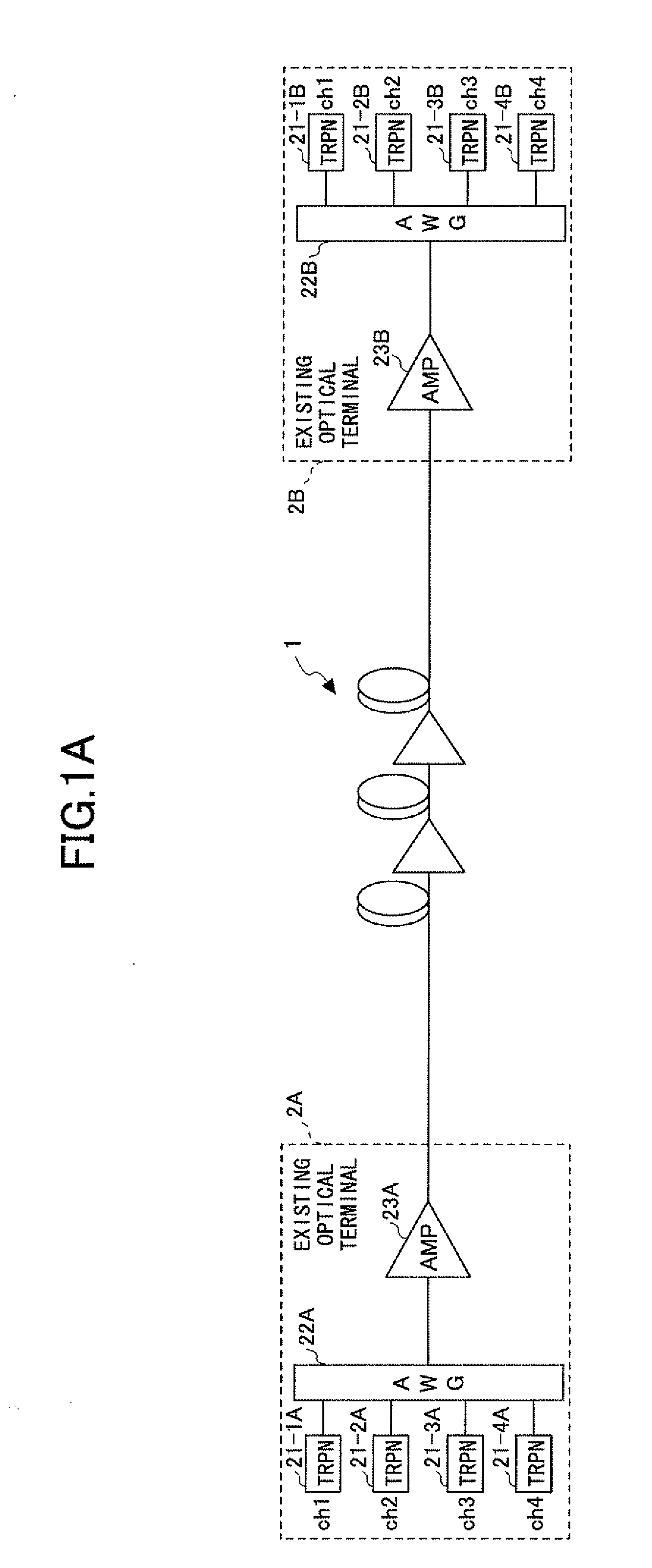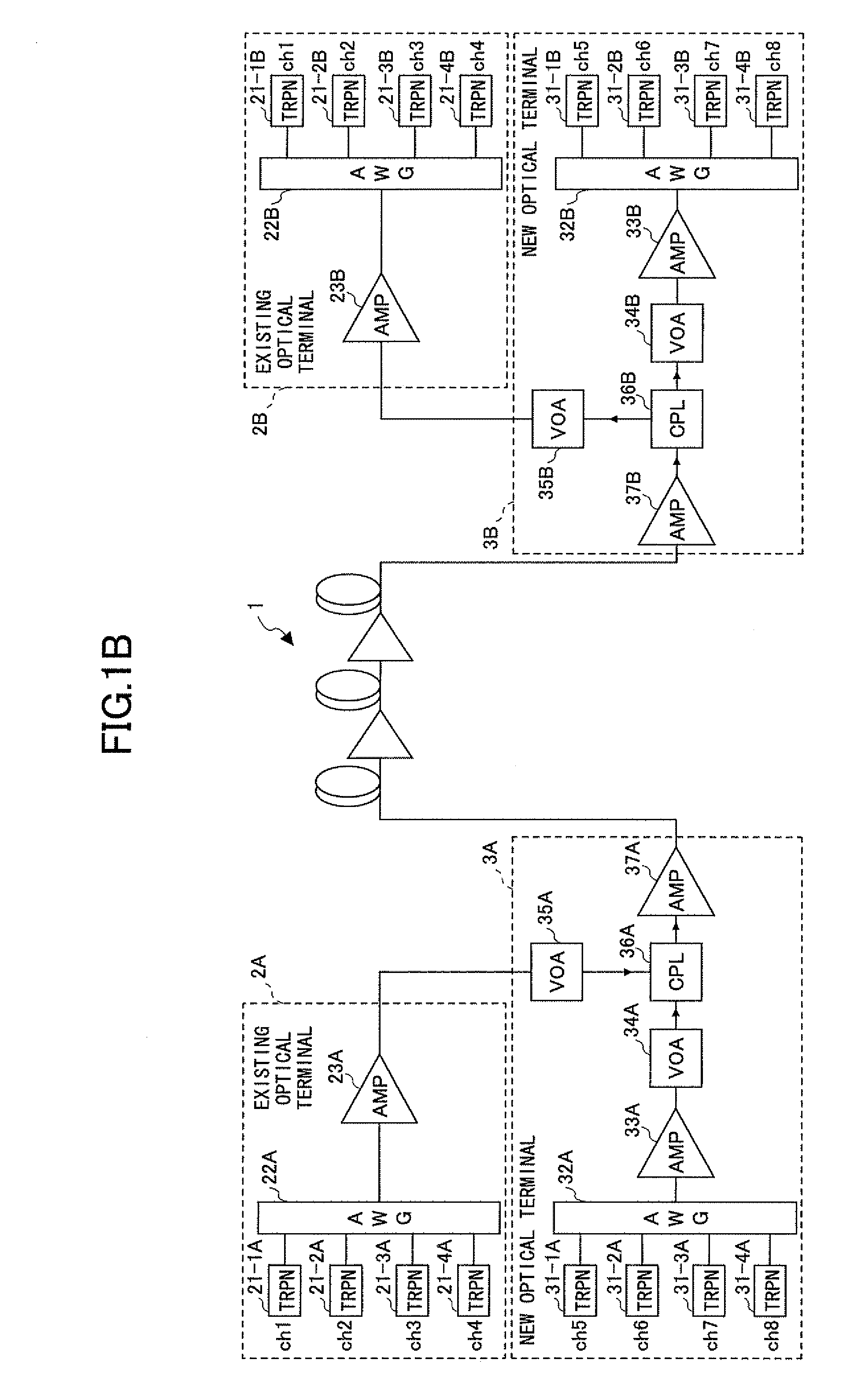Wavelength division multiplexing transmission system
a transmission system and wavelength division technology, applied in the field of wavelength division multiplexing transmission systems, can solve the problems of transmission degradation, optical waveform distortion, and cannot serve as a universally applicable method for increasing transmission capacity, and achieve the effect of slow fluctuation and length of burst errors
- Summary
- Abstract
- Description
- Claims
- Application Information
AI Technical Summary
Benefits of technology
Problems solved by technology
Method used
Image
Examples
first embodiment
[0055]FIG. 4 is a drawing showing an example of the configuration of a transmission side of a system according to a first embodiment.
[0056]In FIG. 4, the configuration of the existing optical terminal 2A on the transmission side is the same as the configuration illustrated in FIG. 1B. Here, the existing channels ch1 through ch4 employ the intensity-modulated RZ-OOK scheme. The existing optical terminal 2B on the reception side also has a similar configuration.
[0057]A new optical terminal 3A on the transmission side has new channels ch5 through ch8 employing the phase-modulated RZ-DPSK scheme. The relationships between these new channels and the existing channels ch1 through ch4 are supposed to be the same as those illustrated in FIG. 1C. The configuration of the new optical terminal 3A is similar to that illustrated in FIG. 1B, with a few differences. Such differences include the provision of polarization scramblers 301-2 and 301-3 immediately after the transponders 31-2A and 31-3A ...
second embodiment
[0064]FIG. 5 is a drawing showing an example of the configuration of a transmission side of a system according to a second embodiment. In this embodiment, a polarization scrambler is inserted into a path after multiplexing, rather than being provided separately for each of the new channels that suffers XPM from an adjacent existing channel. This configuration can provide the same result since the intended effect of polarization scrambling is attributable to changes in relative polarization between an intensity modulated signal and a phase modulated signal.
[0065]In FIG. 5, the optical outputs of the transponders 31-1A through 31-4A corresponding to the new channels ch5 through ch8 are directly supplied to the multiplexer / demultiplexer unit 32A. A polarization scrambler 301 is provided at the output of the optical amplifier 33A situated after the multiplexer / demultiplexer unit 32A. Configurations other than what is described above are the same as those in the first embodiment illustra...
third embodiment
[0070]The third embodiment is directed to a configuration in which the receiver unit of a transponder in the new optical terminal 3B on the reception side is configured to cope with polarization dependency. FIG. 6 is a drawing showing an example of the configuration of a receiver unit of a reception-side transponder using the RZ-DPSK scheme. A 1-bit delay optical interferometer is provided for an optical input to divide the output path according to “0 / 1” of the optical signal, and a pair of balanced photodiodes PD is used to receive light. The output of the balanced photodiodes PD is amplified for provision to a discrimination and recovery circuit. The 1-bit delay optical interferometer is generally implemented by use of a thin optical waveguide formed on a substrate. The waveguide characteristics may vary depending on the polarization of incident light. Consequently, the level of the light received by the balanced photodiodes may be affected by the presence of polarization scrambli...
PUM
 Login to View More
Login to View More Abstract
Description
Claims
Application Information
 Login to View More
Login to View More - R&D
- Intellectual Property
- Life Sciences
- Materials
- Tech Scout
- Unparalleled Data Quality
- Higher Quality Content
- 60% Fewer Hallucinations
Browse by: Latest US Patents, China's latest patents, Technical Efficacy Thesaurus, Application Domain, Technology Topic, Popular Technical Reports.
© 2025 PatSnap. All rights reserved.Legal|Privacy policy|Modern Slavery Act Transparency Statement|Sitemap|About US| Contact US: help@patsnap.com



